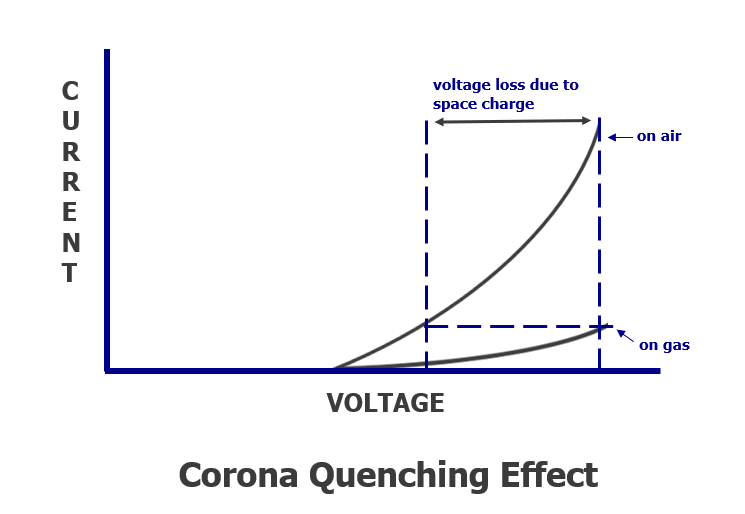Operators of wet electrostatic precipitators (wet ESPs) often notice that the secondary current and voltage readings tend to rise and fall with the particulate loading. This phenomenon is known as space charge corona quenching, and it can have a serious impact on the performance of a wet ESP.
Basically, corona quenching works as follows:
Entering particles are charged to the same polarity of the discharge electrode, thus forming a cloud of space charge. This space charge acts as a back electromotive force (EMF), which tends to reduce the electric field at the discharge electrode and causes a reduction in the corona current for a given voltage reading. To see the effect of space charge on your wet ESP, run air load and dust load VI curves. Find the voltage value on the air load curve that corresponds to the milliamp reading on the dust load curve at the maximum voltage. By subtracting the lower from the higher voltage (see the figure below) you will find the approximate effect, in volts, of the particulate-caused space charge in your wet ESP.

Corona Quenching Effect
Space charge corona suppression is usually associated with “heavy” loadings of particulate, but heavy dust loadings are not necessarily required for corona quenching to occur. The key factor is the specific surface area of the dust expressed as an area/volume ratio. The following example shows how a nominally “light” loading of fine particles can have a much worse impact on the corona current than a “heavy” loading.
As an example, let us assume that we have a 9” diameter tube-type precipitator treating two different aerosols. The first is a “light” loading of particles with a diameter of 0.2 microns at a concentration of .03 grains/acf (68.67 mg/m3). The second is a “heavy” loading of 2-micron particles at a concentration of .3 grains/acf (686.7 mg/m3). If we assume a charge density of 1 charge per each .2-micron particle and apply Gauss’s Law (net flux of an electric field in a closed surface is directly proportional to the enclosed electric charge), we find that the “light” loading will reduce the electric field on the discharge electrode by about 4100 volts while the “heavy” loading will only cause a reduction of 950 volts.
Because of the exponential relationship between voltage and corona current the 4100-volt reduction will probably have a dramatic effect on the corona current while the 950-volt reduction may be slight.
This information also applies to dry ESPs and is not applicable if a back corona is present or if the gas composition is unlike air or normal combustion products.
If you have a contribution let us know – we’d like to hear from you!

